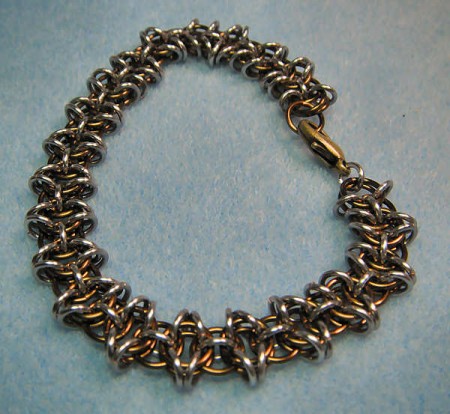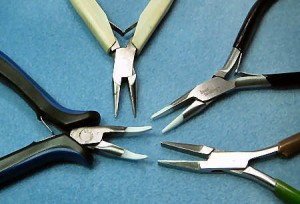Chain Maille 101
 Welcome to chain maille 101! It’s for learning about this cool art form, which is both ancient and new. Ancient because chain maille (also spelled chain mail and chainmaille) has been used as armor for centuries. New because it’s being used now for amazing jewelry (among other things).
Welcome to chain maille 101! It’s for learning about this cool art form, which is both ancient and new. Ancient because chain maille (also spelled chain mail and chainmaille) has been used as armor for centuries. New because it’s being used now for amazing jewelry (among other things).
Intro to Maille
If you’ve heard the term but aren’t quite sure what it is, maille is linking rings so that they form a repeating pattern, known as a weave.
The photo to the right is a pattern called “Celtic Visions” and it’s one of about a zillion weaves out there. OK, I’m exaggerating a little, but there are hundreds, if not thousands, of different ways of joining these rings.
Jump Rings
I keep talking about rings, but what kind? They are known as jump rings, and most of the time are made with metal. The metal rings are cut so that they can be opened and closed. The rubber or neoprene rings are all in one piece.
Without rings, there is no maille. Metals used run the gamut — steel, iron, aluminum, gold and more. When it comes to jewelry, the most common metals are silver (argentium, sterling or silver-filled), gold-filled, niobium, titanium, aluminum, copper and enameled copper. Stainless steel is sometimes used, and bronze has its fans as well. As you can tell, there are lots of options and lots of price points, too.
 If you’re on a budget, try aluminum. Money to burn? Go for gold-filled for a stunning piece of jewelry.
If you’re on a budget, try aluminum. Money to burn? Go for gold-filled for a stunning piece of jewelry.
Tools of the Trade
So what kinds of tools do you need to make chain maille jewelry? Not many!
Two sets of pliers are necessary — one for each hand. While it’s not necessary to buy top-of-the-line, you do want some that have a smooth jaw and are comfortable to hold and use.
Aside from the usual (good lighting, comfortable workspace, magnification or at least protective eyewear), what else? A small straight piece of wire (for opening a path in a tight spot) and some twist-ties are about it. Isn’t it nice to take up a hobby that doesn’t have many tools?
Oh, I’ll talk about it more when I go more in-depth with the kinds of pliers, but you might want to use something like Tool Magic to put a light rubberized coating on the tips of the pliers.
What Else for Chain Maille?
A sense of adventure! You’ll start out learning specific ways of linking the rings so they form patterns. But once you have a good grasp of the basics, you may find yourself exploring. Sometimes it will be a mistake that turns out to be a cool new pattern. Other times you might stare at some rings and think to yourself, “I wonder what would happen if I…”. 🙂
So definitely learn some of the basic weaves first, then move on to the more complex ones. And before you know it, you’ll be finding different ways to connect the rings.
That’s it for now. I’ll be back a little later with more info about rings and pliers — what you need to know before you buy!
Leave a Reply